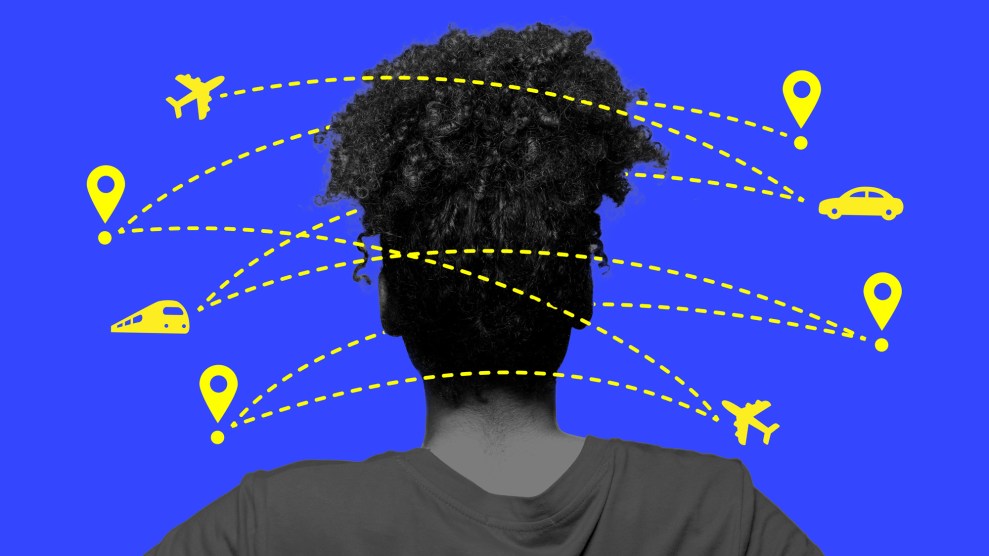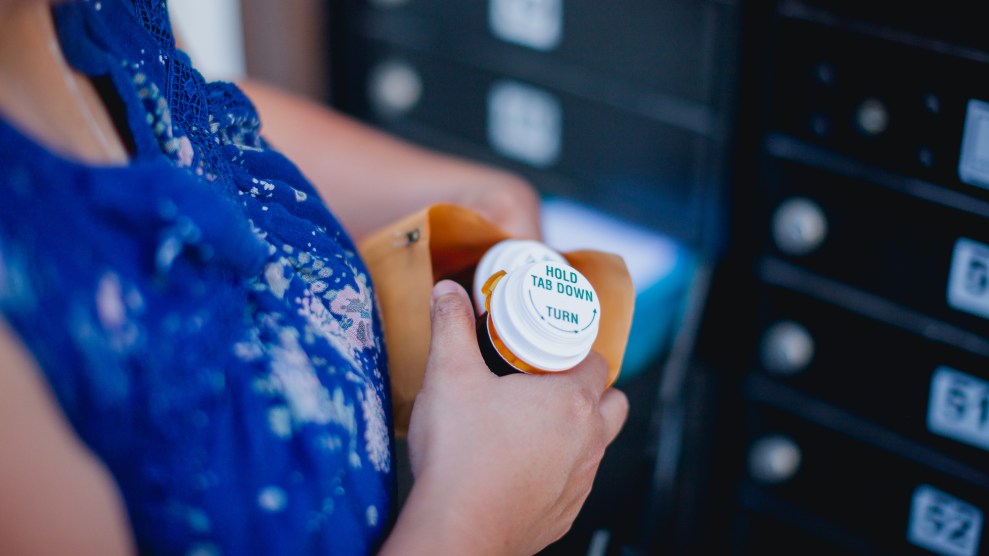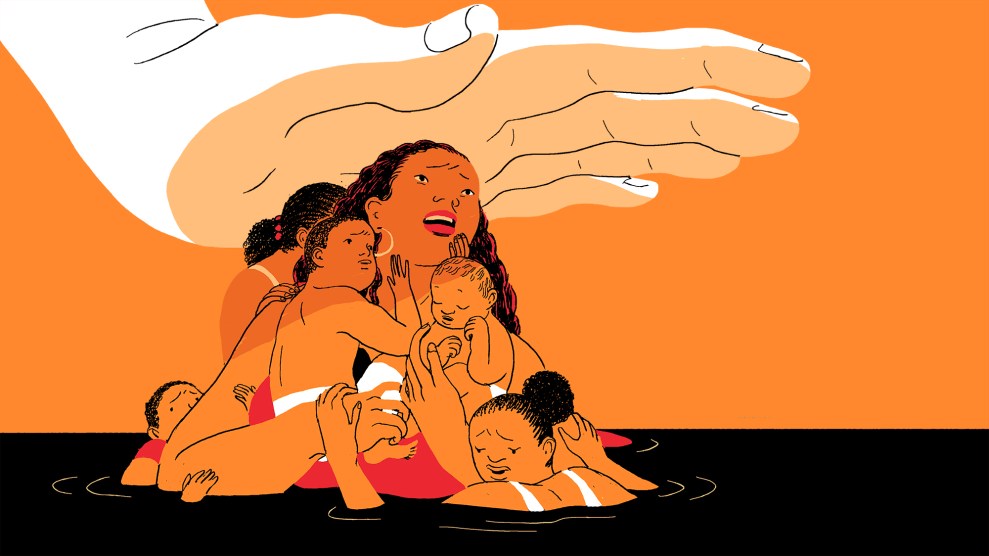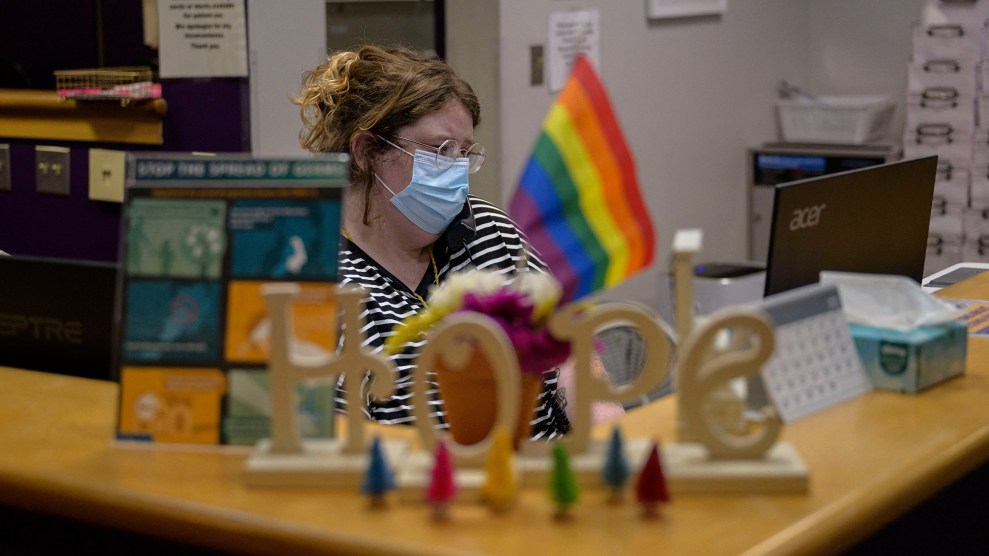
Mother Jones illustration; Getty
It took more than a month to pin down Megan Jeyifo, the executive director of the Chicago Abortion Fund (CAF), for an interview.
She’s been understandably busy, growing CAF from an organization that served roughly 30 Illinois residents monthly in 2016 into one of the largest independent abortion funds in the nation. These days, upwards of 300 people from around the country call in on a weekly basis requesting emergency assistance—a nearly 4,000 percent increase.
The number of employees on CAF payroll has grown, too. Last year there were a mere five, including one part-timer. Fast-forward some 365 days, and there’s 14 staffers on board, with three more on the way by mid-summer.
“The work of abortion funds is not new. The work of CAF is not new,” says Jeyifo. “The scale is what is new.”
Behind the necessary accretions, of course, is the Supreme Court’s June 24, 2022, decision in Dobbs v. Jackson Women’s Health Organization, which overturned fifty years of federal abortion protections and passed the power to regulate, restrict, or ban abortion to individual states. Abortion funds, some of which have existed for decades, have been racing to keep up. And in contrast to their role before Dobbs, which was primarily about funding the cost of abortions, abortion funds today are increasingly taking on the additional, time-intensive role of travel agents, all in the name of getting people to states where it’s legal to have abortions at their respective gestational ages—if at all.
Before the Supreme Court handed down the Dobbs decision, obtaining an abortion in northern Wisconsin, for example, might take two days’ worth of brief appointments and a couple hundred dollars. After Dobbs, the state regressed to its 1849 abortion law, which makes it a felony to provide any abortion except when necessary to save a mother’s life. Now, a pregnant person from the same area may have to drive seven hours each way to Chicago and stay in a hotel to account for appointment times and recuperation. They might need more childcare because they are away from home longer. And more food and fuel because they are driving a far greater distance.
Abortion funds aren’t just paying for these additional costs. They are also, in many cases, booking the arrangements with the clinics, airlines, hotels, and transit companies. Jeyifo credits a past life in the hospitality-restaurant industry as preparing her to “build space into my day for fires,” she tells me between bites of lunch. It’s 2:30 pm in Chicago, and the first time she’s eaten all day. “Previously it would be because a dishwasher broke or the meat order didn’t come through. Now the stakes are a bit higher.”
Since 2017, when Illinois Governor Bruce Rauner signed a bill into law expanding public funding of abortion in the state, including to Medicaid recipients, CAF’s money has gone further, enabling it to help people outside of Illinois. The thinking was that they wanted to help people get abortions wherever it was most convenient and cost-effective, and Illinois, which has long had more abortion protections than its neighbors, often made sense. But given the surrounding states’ new abortion restrictions post-Dobbs, many now have no choice but to venture to Illinois. Data collected by the Guttmacher Institute and analyzed by Bloomberg in 2022 estimated that post-Dobbs abortion restrictions would lead to an 8,000 percent increase in the number of women of reproductive age whose closest abortion provider is Illinois, where CAF is one of the largest abortion-support organizations. Bloomberg estimated abortion-friendly California would see an influx of patients nearing 3,000 percent.
Serving these out-of-state populations takes significant cash. About a year ago, CAF averaged giving $175 to people for the abortion procedure itself, plus $120 for other affiliated needs, like gas. Now the group pledges an average of $422 for abortion costs and $390 for miscellaneous extras, such as hotels and flights for out-of-staters.
CAF isn’t alone in vastly increasing its outlay post-Dobbs. The Colorado Doula Project, which provides abortion funding and other practical support, went from spending $275 on abortion funding and related expenses in August 2021 to $32,000 in August 2022—a 11,536 percent surge. The fund’s annual budget was $20,000 pre-Dobbs, executive director Gina Martinez says. Now, it’s budgeting for $370,000, with some of the money going towards buying closed-toed shoes and warm layers for travelers from abortion-banned states like Oklahoma and Texas.
In Nevada, which has become a hub for pregnant people in abortion-banned Texas and abortion-restricted Arizona and Utah, the number of callers requesting assistance from the Wild West Access Fund has doubled from a weekly average of 12 to 15 in 2021 to 25 to 30 this year.
“After May of 2022,” president Macy Haverda says, referencing when the Dobbs decision leaked, “everything kind of went to hell very quickly.” Her mostly volunteer-based organization had to hire a staff member to keep up with the new client volume. “We weren’t prepared to do that,” she says.
One thing that’s working for the abortion funds, amid the chaos, is what Martinez calls “solidarity funding.” Both she and Jeyifo mentioned nonstop group texts coming in on the encrypted messaging app Signal (they use it to protect the confidentiality of both their staff and clients, who in some places could be criminalized for seeking an abortion or helping someone obtain one). On these channels, the abortion funds can ask each other for help funding more expensive cases, ones in which, for example, a client is further along in a pregnancy or needs to travel a greater distance.
Martinez recalls one such client: a woman traveling from an abortion-banned island in the Caribbean to Denver. When I offhandedly mention that to Jeyifo, separated from Colorado by 1,000 miles, she chimes in that CAF is one of several organizations helping the Colorado Doula Project with this woman’s case.
“That’s just a standard practice for abortion funds all over the country, all of whom are scraping pennies together every month to get by,” Martinez says.
These are the little wins that bring joy and motivation to Oriaku Njoku, the executive director of the National Network of Abortion Funds, a group providing resources to over 80 abortion funds across the country. “It is rooted in so much happiness, and a commitment to this collective responsibility that we have to our communities,” Njoku says. “Hearing that abortion funds worked together to come up with $15,000 to pay for someone’s abortion—that to me is means to celebrate.”
That doesn’t negate the challenges, though. Abortion funds need more money for more people traveling further—distances that may get even greater as more state abortion restrictions work there way through courts. The funds will have to sustain these growing needs and keep up with all the shifting regulations while also accounting for the fact that donations may eventually dwindle as the cause loses momentum. “It would be naive to think that people are going to be supporting us with the levels they have over the last year,” says Jeyifo. “However, I do think that there are enough people who recognize the responsibility.”
Before hopping off our call—which likely only happened because I followed up to my persistent emails with a text—Jeyifo tells me what keeps her grounded amid the chaos of running an abortion fund: jumping on the phone lines to work with clients herself. “Figuring out numbers, and a budget, and development, and how to grow the staff, and how to figure out what insurance we can provide, or what our strategic plan is going to look like—it is not as immediately gratifying as connecting someone to all the resources they need to get an abortion,” she says.
But for Jeyifo, jumping back on the phone lines will have to wait for a bit. She has meetings to attend, dozens of Signal messages from other abortion funds to respond to, and 220 emails to read. She can mark at least two of those emails—from me, asking for an interview—off her list.













